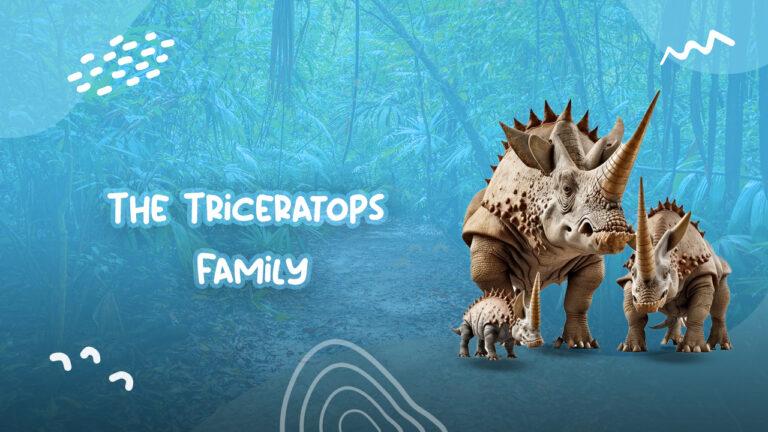Amazing Facts about Triceratops Family

The Triceratops family is one of the most iconic dinosaur families in the world. They are known for their large, three-horned heads and their impressive size.
This article will explore the fascinating things regarding Triceratops’ eggs, armor, sounds, teeth, fossils, and behaviors.
The Triceratops Family
The Triceratops family is one of the most well-known and beloved dinosaur families in the world. The Triceratops family consists of the genera Triceratops, Torosaurus, and Nedoceratops. All three genera have similar physical attributes, including large horns on their heads, powerful beaks, and thick neck frills. However, there are some key differences between the genera.
Triceratops is the most well-known of the three and is easily identified by its three horns and its distinctive neck frill. Torosaurus, on the other hand, is considerably larger than Triceratops and has two horns instead of three. Finally, Nedoceratops is the smallest of the Triceratops family and is distinguished by its small horns, which are located near the eyes, and its lack of a neck frill.
What is Triceratops
Triceratops, an iconic figure in the Triceratops Family, is known for its large skull with three horns and a strong frill, typical of Chasmosaurine Ceratopsids from the Late Cretaceous’s late Maastrichtian stage.
As one of the most recognizable dinosaurs, it was a massive, quadrupedal herbivore, reaching 9 meters in length and weighing up to 6.1 metric tons. Its skull featured a short beak and deep jaw, with teeth perfect for slicing and grinding vegetation, highlighting its significant role in the Late Cretaceous’s ecosystem.
Triceratops Pronunciation
The name Triceratops, which means “three-horned face”, is a combination of the three Greek words ‘tri-keras-ops’. The ‘tri’ meaning “three”, ‘kéras’ meaning “horn”, and ’ōps’ meaning “face”.
Triceratops Fossils
Triceratops fossils, belonging to the Triceratops Family, have been found all over the world, from North America to Europe and Asia. They are one of the most well-known dinosaurs, and their fossils are some of the most sought-after by paleontologists.
Triceratops are thought to have lived in large herds, as evidenced by fossilized tracks and bones in multiple locations. Fossils of Triceratops have been found in great abundance, and they are one of the most well-documented and studied dinosaur genera. These fossils have provided scientists with a wealth of information on the Triceratops family, such as their diet, behavior, and anatomy.
Triceratops Habitat and Behavior
Triceratops, a member of the Triceratops Family, is thought to have lived in herds and may have been a territorial animal. It is believed to have been an active forager and may have used its horns and frill to defend itself from predators such as Tyrannosaurus rex.
Triceratops were social animals, living in herds and grazing on plants. They were also quite intelligent, able to recognize and remember other members of their herd, highlighting the complex social structures within the Triceratops Family.
Triceratops Skeleton
According to DJ Emlen in 2014, Triceratops skeleton fossils have been discovered in North America, Europe, and even as far as Asia. They are large, herbivorous dinosaurs that are characterized by their three distinct horns and a beak-like mouth.
Triceratops Skull
In 2010, JD Currey of the Journal of the Mechanical Behavior of Biomedical Materials published a paper on the biomechanical properties of Triceratops skulls. Currey’s paper found that the Triceratops skull exhibits a high degree of structural strength, even when compared to other strong skulls in the dinosaur family. This finding indicates that the Triceratops family likely had a complex and sophisticated social structure, which likely included the ability to defend themselves against predators.
Furthermore, Currey’s paper also showed that the Triceratops had a unique skull shape and structure, which likely allowed them to be very mobile and agile. This suggests that the Triceratops family was capable of quickly adapting to changing environmental conditions. All of these findings indicate that the Triceratops family was a highly evolved, sophisticated species with an array of evolutionary advantages.
Triceratops Head
According to RMN Alexander’s 1989 book, they were a large, herbivorous dinosaur with a large, frill-like head crest and three horns. The horns were believed to have been used for defense, as well as for display during mating rituals.
They were also believed to have been quite intelligent, as their brains were one of the largest of all the dinosaur species. They were believed to have had a highly developed sense of sight, smell, and hearing. They were also believed to have been social animals, as they were often seen in groups.
Triceratops Egg
One of the most interesting aspects of Triceratops is its egg. Triceratops (from the triceratops family) eggs were large and round, measuring up to 10 inches in diameter. They were usually laid in clutches of up to 10 eggs and were covered in a thick, leathery shell. The shell was designed to protect the eggs from predators and the elements and was often decorated with intricate patterns.
Triceratops Armor
Triceratops, from the triceratops family, had a unique form of armor that protected them from predators. Its body was covered in thick, bony plates, and its head was protected by a large, bony frill. This armor was designed to deflect blows from predators, and it was also thought to be used for display purposes.
Triceratops Sound
It is unknown exactly what sound Triceratops made but an idea can be determined. An idea of what kind of sound it is most adapted to hear. The 3D x-ray of the Triceratops’ skull shows tiny bones of its inner ears which means that it can hear frequencies. The frequency was as low as the D-note. This sound was thought to be used to warn other Triceratops of danger, and to attract mates. Probably, as per research, Triceratops make low-pitch sounds.
Triceratops, a member of the triceratops family, had a unique sound that was used to communicate with other members of its species. It was a low, rumbling sound that could be heard from up to a mile away. This sound was thought to be used to warn other Triceratops of danger, and to attract mates.
Triceratops Teeth
Triceratops, a pivotal member of the Triceratops Family, had a unique set of teeth that were designed for grinding vegetation. Its teeth were large and flat, and were arranged in a beak-like formation. This allowed it to efficiently chew and digest its food.
How Fast Can A Triceratops Run
Triceratops was a large, four-legged herbivorous dinosaur, from the most iconic dinosaur families in the world – Triceratops Family. While they were not the fastest dinosaurs, they were still quite capable of moving quickly when necessary.
Triceratops Speed
The speed of Triceratops, from the Triceratops Family, is estimated at up to 25 miles per hour, impressive for its estimated 6-ton size. Their speed and agility were attributed to long, muscular legs, a powerful tail, and a strong, flexible neck, enabling quick maneuvers and escape from predators. The agility of Triceratops, including their ability to make sharp turns and jump obstacles, played a crucial role in their survival.
Conclusion
The exploration of the Triceratops family offers an amazing glimpse into the prehistoric past, painting a vivid picture of these fascinating creatures that roamed the earth millions of years ago. The Triceratops’ fossil remains have unveiled impressive information about their unique physical features, such as their large, robust skulls with distinctive horns and a strong frill, which were crucial for defense and possibly for social interactions within their species.
Additionally, studying their behaviors, from their social herd dynamics to their herbivorous diet, alongside the extensive fossil record, has significantly enhanced our understanding of the world of dinosaurs. This comprehensive insight into the Triceratops family not only enriches our knowledge of these iconic dinosaurs but also contributes to our broader understanding of the Late Cretaceous ecosystem and the evolutionary history of Ceratopsids.
Enjoying reading about dinosaurs? Read more at Dinosaurzus!

Top posts
related articles
Discover the Awesome Top 10 Longest Dinosaur Names
Dinosaurs, the ancient giants that once roamed the Earth, continue to capture our imagination. While
Discover the Amazing Dinosaur with 500 Teeth
Dinosaurs have always fascinated us with their colossal size, unique features, and intriguing mysteries. One
The Acheroraptor: An Insight into a Tiny but Fierce Dinosaur
The dinosaur world is undoubtedly fascinating, and the relative discovery of the acheroraptor is no
Epic Tale: Cryolophosaurus, Rise of the King
Cryolophosaurus, also known as the ‘Antarctic King’, was a fierce and fascinating dinosaur that existed
Torosaurus: The Horned Dinosaur with a Mysterious Identity
Dinosaurs don’t exist anymore, but their fossils still fascinate us. Paleontologists scour the earth to
Exploring the Wondrous World of Corythosaurus
The world of dinosaurs never stops fantastic us. From the huge T-rex to the tiny


